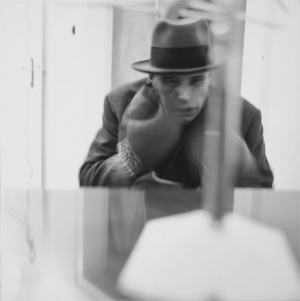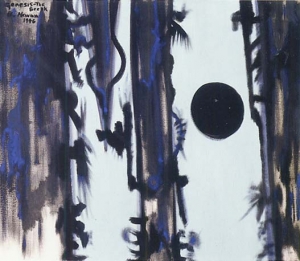|
Displaying items by tag: joseph beuys
Last month the German state-owned bank Portigon AG of North Rhine-Westphalia, the rebranded successor of the WestLB which folded in 2012 during the financial crisis, decided to deaccession its entire art collection. The bank holds approximately 400-pieces of art, which includes works by Pablo Picasso, August Macke, Joseph Beuys, and Günther Uecker.
Now officials in the German state of North Rhine-Westphalia are preparing a plan to save the collection of the state-owned bank, Rheinische Post reported.

The Kunstmuseum Basel presents 'Joseph Beuys: Installations, Actions, and Vitrines', Beuys is considered to be one of the most prominent artists of the 20th century. the artist's work has always elicited a wide variety of responses; some believe that Beuys was a great visionary who pushed the limits of what art can be, while others see him as embodying an authoritarian idea of the artist that younger generations, in particular, regard with baffled skepticism. His significance, however, is beyond doubt, as his continuing influence on today’s art makes manifest. The exhibition, which opened at the Museum für Gegenwartskunst, explores the collection’s holdings of Beuys and the ways in which they have been interpreted in the past. It complements these works, primarily installations, with films on loan that show Beuys during his actions.
Past presentations of the works in the collection of the Museum für Gegenwartskunst Basel have not included films or other documentary materials illustrating Joseph Beuys’s actions.
The first thing you see in “Sturtevant: Double Trouble,” the Museum of Modern Art’s taut and feisty retrospective of the American artist Elaine Sturtevant, is work by artists far better known than Ms. Sturtevant herself.
Right at the start is the familiar 1972 photographic portrait of the German Conceptualist Joseph Beuys, in his porkpie hat and flak jacket, striding toward the camera. A bit farther on you’ll find Jasper Johns’s 1955 “Target With Four Faces,” a combination of painting, collage and sculpture and a MoMA treasure. Near it is Eliot Elisofon’s classic 1952 time-lapse photograph of Marcel Duchamp descending a staircase.
Eva Beuys, the widow of Joseph Beuys has changed her tune about the trio of artists who used the remnants of her late husband’s Fettecke (1982) to make schnapps.
Despite telling Bild on Wednesday that she had no interest in pursuing legal action against the artists—Markus Löffler, Andree Korpys, and Dieter Schmal—she has now retained the services of German art lawyer extraordinaire, Peter Raue.
The University Museum of Contemporary Art (UMCA) at the University of Massachusetts at Amherst has received a gift of six original never-before-exhibited Andy Warhol prints from the Andy Warhol Foundation for the Visual Arts.
All with Warhol’s recognizable style and focus, the prints represent a period of the artist’s work from the late 1970s to mid-1980s, not long before the Warhol’s death in 1987 at the age of 58. The prints depict a range of subjects, from fashionable portraits to popular culture, and include such iconic images as Warhol’s portrait of friend and fellow artist Joseph Beuys and his striking representation of Lakota chief Sitting Bull.

Widely considered one of the greatest sculptors of all time, British artist Henry Moore played a pivotal role in translating modernism into three dimensions. A new exhibition at the artist’s former home in Hertfordshire, England, examines the influence that Moore’s soaring, organic sculptures had on contemporary art.
“Body & Void: Echoes of Moore in Contemporary Art” presents works by some of the world’s most celebrated contemporary arts, including Damien Hirst, Rachel Whiteread, Antony Gormley, and Anish Kapoor. Works by a number of post-war artists, such as Joseph Beuys and Bruce Nauman, are also included in the exhibition. Site specific works by leading British artists Richard Deacon and Robert Long have been commissioned as part of the show.
“Body & Void” presents sculptures that examine Moore’s central themes, including the exploration of internal and external space, mother and child, and figures in a landscape, alongside contemporary works that touch on the same topics. For example, Hirst’s “Mother and Child (Divided),” a bisected cow and calf floating in giant tanks of formaldehyde, appears between Moore’s rose marble sculpture “Mother and Child” and “Stringed Mother and Child,” a single plaster cast that features two forms connected by a series of cords. The three works explore the same mother and child relationship in vastly different ways.
“Body and Void” fills the galleries and gardens at Perry Green, where Moore lived and worked for 50 years. The estate is also home to the Henry Moore Foundation, which was established by the artist in 1977. Although Moore amassed considerable wealth during his lifetime, he chose to live frugally and put most of his fortune towards endowing the Foundation, which continues to support education and promotion of the arts.
“Body & Void: Echoes of Moore in Contemporary Art” will remain on view at Perry Green through October 26.

The Ashmolean Museum in Oxford, England will partner with the Hall Art Foundation to present a series of exhibitions of contemporary and post-war art drawn from the collections of the Hall Art Foundation and Andrew and Christine Hall. Together, the Foundation’s collection and that of the Halls includes some 5,000 works by Richard Artschwager, George Baselitz, Joseph Beuys, Eric Fischl, Anselm Kiefer, Ed Ruscha, Andy Warhol and many other important contemporary art figures.
The collaboration will kick off on October 8, 2013 with an exhibition of works by leading British-born artist, Malcolm Morley. Malcolm Morley at the Ashmolean: Paintings and Drawings from the Hall Collection will present 30 works dating from 1964 to the present. Morley, who often paints colorful scenes of man-made disasters, is considered one of the founders of hyperrealism, a genre of painting resembling a high-resolution photograph. Malcolm Morley at the Ashmolean will be on view through March 30, 2014.
The partnership between the Hall Art Foundation and the Ashmolean Museum is expected to develop into a long-term relationship and will eventually include a new contemporary art gallery at the institution.

The Dia Art Foundation, which closed its two galleries in Manhattan in 2004, has gathered about half the money needed to build its new space in New York City’s Chelsea neighborhood. While the organization has pushed their fundraising efforts into high gear, they are left without an acquisition fund for its collection, which includes works from the 1960s to the present.
The Dia Art Foundation announced that they will be holding a sale of paintings and sculptures at Sotheby’s in New York on November 13-14, 2013 to remedy that. The foundation hopes to raise at least $20 million by auctioning off works by Cy Twombly (1928-2011), John Chamberlain (1927-2011) and Barnett Newman (1905-1970).
The Dia Art Foundation’s collection includes works by modern and contemporary artists such as Andy Warhol (1921-1987), Joseph Beuys (1921-1986) and Louise Bourgeois (1911-2010). Philippe Vergne, the Dia’s director, has not commented on what works he’s hoping to acquired with the funds from the Sotheby’s sale.

Contemporary art is occupying hallowed halls this season: Andy Warhol at the Met, Matthew Barney at the Morgan Library.
And Conceptualism, which 40 years ago proposed trashing museums altogether, is now assuming old master status in them. It’s even getting a historical survey in “Materializing ‘Six Years’: Lucy R. Lippard and the Emergence of Conceptual Art,” a show that opens at the Brooklyn Museum on Friday and provides the back story for a surprising number of other shows, mostly of new art, coming in the months ahead.
Not that the Brooklyn exhibition has blockbuster potential; if anything, the opposite is true. It’s a compendium of archival odds and ends: postcards, snapshots, arcane pronouncements. And it’s based on a 40-year-old scrapbook of a book with an interminable art-speak title, of which “Six Years: The Dematerialization of the Art Object from 1966 to 1972: A Cross-Reference Book of Information on Some Esthetic Boundaries” is just the first quarter. Compiled by Ms. Lippard, a pioneering feminist writer and curator, and published in 1973, the book remains a founding document of a hugely influential kind of art that emerged from an era of social upheaval and that spurred far-reaching changes in thinking about what art could be — meaning, among other things, unheroic, non-Western, female, ephemeral.
|
|
|
|
|